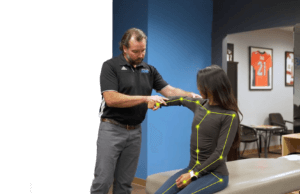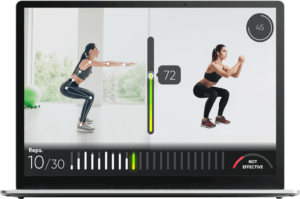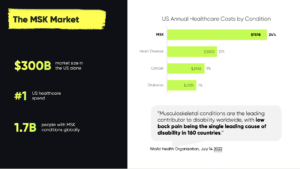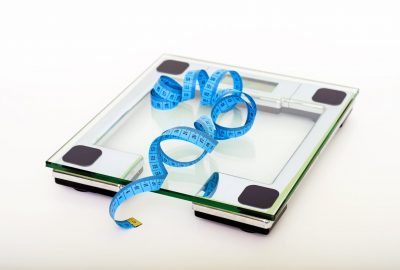Physiotherapy is an integral part of patient treatment and recovery from MSK conditions, whether for chronic conditions, sports injuries or other issues. The ability to track the movements and posture of the body could guide and correct patients through prescribed exercises, determining how well a treatment plan is working and also provide insights into future treatments. This has traditionally been done in person or by passive guidance using paper instructions or regular videos on computers, smartphones or tablets. But new AI-powered technology is changing that.

The use of AI in MSK and physiotherapy is a relatively new concept, but it holds the potential to revolutionize the way we treat people with physical ailments. The technology could help clinicians streamline treatment plans based on real-time data and improve outcomes for patients by providing real-time feedback and corrective guidance on how their bodies move.
AI-enabled physiotherapy is taking the underlying technology of motion tracking to new heights using computer vision for human motion analysis. This technology can accurately capture movement patterns in real-time, while performing musculoskeletal physiotherapy exercises and without needing any physical contact with the patient, providing insights that could lead to more effective treatments while also improving efficiency at clinics across the world.
Where is traditional Physiotherapy lacking?
Physiotherapy focuses on the physical and mechanical functions of the body. It aims to improve mobility, relieve pain, reduce inflammation and increase strength or endurance. Physiotherapists use manual therapy techniques such as massage, stretching, and more than anything – exercises to help treat injuries or disorders. They might also employ modalities like ultrasound and electrical stimulation. A key limitation with traditional human-interaction based Physiotherapy is that the therapists cannot guide their patients on a daily basis, ensuring they are following their home exercise protocol and exercising correctly. Physiotherapists most often don’t have access to the patient-specific data that would help them provide more personalized treatment based on actual results. At best, they can provide basic physiotherapy exercises online via standard, passive, video apps or youtube.
As a result, traditional physiotherapy can be expensive and inconvenient. While home exercise protocols are an essential part of the treatment, adherence is very low and even those who do perform the exercises at home have no guidance while exercising which means that they might be performing their MSK therapy exercises the wrong way. Physiotherapists are a critical component but cannot scale to support each patient every day, leaving most of the treatment to be unsupervised.
All of these issues make the traditional physiotherapy process an imperfect solution for many people suffering from musculoskeletal injuries—and that’s where AI technology for physiotherapy comes in. By leveraging standard webcams on computers, phones or tablets, technologies such as Kemtai Motion-tracking can capture every move that the patients make during their home exercising—turning any device with a camera into a digital therapist.
A brief history of Motion Tracking
Motion capture is a process that tracks the intricacies of live movement and processes this information either live or by recording. It is used in many different fields—from military applications to medical uses—and for entertainment as well.
Initially, motion capture was accomplished via rotoscoping, invented by Animator Max Fleischer in 1919. Rotoscoping is the process of recording actual footage and tracing over this footage frame-by-frame. The technique of creating characters that move with the fluidity and realism of a human being has been essential to most animated films in history, including “Alice in Wonderland” and “Snow White”.
In recent years, new digital motion-capture systems have emerged that use sensors to track a user’s movements and potentially correct or score them. While sensor-based motion tracking for physio and MSK is a great improvement, these sensor-based systems have several drawbacks: high cost of equipment, low accuracy due to limited number of sensors and the hassle that patients experience in manually positioning the sensors by themselves, contributes to a low adherence rate. Other systems use optical motion capture technology that tracks movement based on reflective or light-based markers attached to the person’s body. Such systems require effort to position markers and are susceptible to occlusion (a blockage of the line of sight) and ghosting caused by reflections, which lead to errors in tracking. The technological and logistical complexity involved with sensor or marker-based motion capture is why many people look at motion capture as an expensive process, when in fact it could be much more accessible with the right tools and technology. AI motion tracking for human motion analysis is a new technology that has been gaining popularity over the past few years. Using a combination of computer vision and machine learning, AI motion tracking achieves motion capture without the aid of physical markers or any additional equipment.
The benefits of AI Physiotherapy
AI physiotherapy has several advantages over the traditional physiotherapy that we are used to. This could be especially true for patients who have chronic pain or injuries that require frequent treatments and regular exercising at home, based on a prescribed home exercise protocol. In these cases, AI physiotherapy may help reduce treatment time, increase the accuracy and consistency of treatment plans, and prevent human error from ever happening again.
Effective Treatment, Faster Recovery
AI-guided home exercising can provide a high level of care. Musculoskeletal physiotherapy exercises play a key role in rehabilitation and recovery from MSK issues. Therefore real-time feedback and corrective guidance could increase the adherence to online physiotherapy exercises and could make remote physical therapy effective, both for the patient and the therapist.
Personalized Care
With the traditional physiotherapy tracking progress is difficult as it relies on human measurement and visits to the clinic for assessments, and it can be challenging for patients to get in touch with their physical therapists. AI-powered therapy could enable patients to continuously and precisely track their progress. Frequent communication of the patient’s progress to the Therapist, supported by AI algorithms, may allow for the optimization of treatment programs based on the patient’s needs, which means that they can work around any limitations or restrictions that may come up during the course of their recovery.
Increased Flexibility
AI physiotherapy can work around the clock, which means that it might be used as a prevention tool for injuries or as an aid during rehabilitation. The fact that it is practically an on-demand service available 24*7 makes it easier for patients to keep up their exercise protocol whenever they have time for it. Since remote technology is used to monitor patient progress and adjust therapy accordingly, appointments may be flexibly scheduled. Patients will hardly feel like they are missing out on treatment due to difficulty in scheduling sessions.
Continuity of Care
Apart from providing real-time corrective feedback and tracking of progress, AI-based remote physical therapy makes it convenient for patients to get in touch with their therapist at any time. It also could provide a constant reliable interface in the physical absence of the therapist and quantitative tracking of their actual progress. This means that the patient may feel holistically included in their recovery journey and can easily share relevant information with their family, doctors or health care providers who need it.
Access and Affordability
A common barrier for people who need physical therapy is their lack of access to an affordable and convenient option; however, AI-powered therapies are significantly more affordable than traditional ones—and this affordability doesn’t sacrifice quality! The software tracks each patient’s progress over time so that they are constantly improving at a pace that’s right for them. While AI physiotherapy is more accurate than traditional forms of practice, it’s also more accessible. For people who don’t have time to go into a physical therapy office on their lunch break or after work, this type of therapy offers them an opportunity to get better without leaving home.
Digital MSK might be used to treat large numbers of patients in a short time without requiring any manual labor from a human therapist. It could be used to make a patient’s recovery process more effective and efficient, while also might eliminate the need for human intervention in many cases.
How AI Physiotherapy works
AI Physiotherapy is a new form of treatment in which the AI learns a patient’s movement patterns and uses that information to provide active feedback and corrective guidance. It can be designed to help patients achieve their physical goals by taking into account their unique characteristics such as age, gender, demography, and medical history. AI-enabled physiotherapy has been used successfully with stroke survivors at the University of California San Francisco Medical Center who have been able to regain function that had previously eluded them through traditional therapy approaches alone (Link to study).
Using AI Physiotherapy for MSK takes motion tracking to new heights by using machine learning to identify the patient’s unique movement patterns, providing active feedback and corrective guidance. It also takes into account the patient’s capability, performance, and physical goals, thereby might shorten the path to recovery, and might do it more personalized and effective.
Who benefits from AI Physiotherapy at home?
Home-based AI Physiotherapy has been found greatly effective in assisting with injury recovery and rehabilitation programs. The AI provides feedback on performance during exercise routines that would idealy be conducted under supervision at a clinic or gym.
AI Physiotherapy could be used to track progress and monitor the effectiveness of treatment. Since the purpose of this technological innovation is to try to improve exercise effectiveness and patient adherence rate, this may be beneficial for patients who have been diagnosed with MSK conditions as they may require prolonged treatment with recommended home exercise routines. Learning from the patient’s continuous progress allows the AI to also be used as a diagnostic tool by the Physiotherapist. Motion Tracking may also be used to monitor and provide active feedback that might improve a patient’s gait. This could be beneficial for anyone who uses walking aids such as crutches or wheelchairs because it may allow them to retain some level of independence by reducing falls and improving mobility.
The stretched therapist!
Physical therapists have many tools available when creating a personalized treatment plan for their patients. However, ensuring that the patient is adhering to the recommended home exercise regime and actually doing the exercises correctly is an altogether complex challenge that has no reliable support tools so far. Also, providing timely and relevant feedback and adjusting the recovery plan to effectively accelerate each patient’s recovery is extremely difficult for the Therapist. AI physiotherapy using adaptive motion-tracking technology could not just help Therapists ensure accountability from their patients, they could also have access to quantitative data about the progress of each patient and what kind of adjustments to the routine may be best at different stages of healing for each individual.
Physiotherapists are in a unique position to hold their patients accountable, as they can measure the success of treatments by how well people follow through with recommended exercises. AI physiotherapy may provide adaptive guidance and feedback and therefore could be a key tool in the arsenal of today’s stretched physiotherapists.
The rise of Digital MSK
Digital Musculoskeletal Therapy is a growing market. MSK as a branch of medicine is complex and on the rise. For example, the U.S Department of Health and Human Services reported more than 5 million Americans were diagnosed with osteoarthritis in 2018 alone, a sharp increase from 4 million cases in 2006. The global physiotherapy services market is estimated to reach $165.73 billion by 2023!
The number of people diagnosed with MSK conditions continues to grow as our population ages and lifestyles change; it’s no surprise that many patients are seeking relief from their symptoms through modern treatments like digital physiotherapy or physical therapy delivered remotely over video conferencing platforms like Skype or Zoom™ (where clients can see their physiotherapist face-to-face).
The treatment of MSK conditions has a huge potential for disruption through machine learning and computer vision. A good example is where deep learning algorithms can analyze images for structural anomalies that would be invisible to humans and recommend corrective actions. The technology once collated into a cohesive platform, can be used by patients, practitioners and providers to great success. Digital MSK has the potential to change the effectiveness of treating musculoskeletal disorders such as arthritis.
Research backs ‘Remote Physical Therapy’
Remote physiotherapy is a growing industry. It’s one of the most promising applications for AI in healthcare today. Studies have shown that remote therapy can be just as effective or in some cases more effective than in-person treatment and has many benefits over traditional forms of treatment. It not just makes access to care more convenient for patients who live far away from their physical therapists or don’t have insurance to cover regular visits to a clinic or hospital, but also enables the most effective path to recovery through AI backed adaptive guidance and feedback.
Results of recent systematic reviews on its effectiveness suggest that digital remote therapy should be considered as an alternative to usual face-to-face treatments. Cottrell et al. [1] analysis reported that real-time telerehabilitation contacts reduce pain and improve physical function in various musculoskeletal conditions. In agreement with this finding, the feasibility and potential of improving surgical patient outcomes have also been proven by van Egmond et al. [2].
The number of physical therapists providing digital remote physiotherapy during the first COVID19 lockdown increased in Switzerland from 4.9% to 44.6%, suggesting a positive context-driven adaptation and capability to respond to new demands within their healthcare system. It is remarkable and also a testament to the effectiveness of technology that this concept has become quite successful in the context of a profession traditionally marked by faith in therapeutic touch.
Physiotherapy is changing, and it’s all thanks to AI. As the industry becomes more tech-savvy, we’ll see more physiotherapists using intelligent assistants as a way to make their work more effective and accessible. AI could be used in many different ways; whether it’s remote therapy through digital MSK or autonomous rehabilitation programs that follow patients throughout their recovery process, this technology has shown enormous potential.
Kemtai: Leading the AI revolution in Physiotherapy
Kemtai’s Motion Intelligence Platform connects the user to an entire ecosystem of exercise tools. Using artificial intelligence and advanced computer vision to analyze human motion and provide real-time training feedback, Kemtai could be used to provide exercises for physiotherapy and fitness. By providing a personalized home-fitness gym with training feedback on a browser or in an app, without the need for any accessories or expensive fitness devices, Kemtai’s Technology has removed unnecessary complexity from Physical Therapy. Our proprietary Motion Tracking technology can be coupled with existing fitness offerings to boost the technological value of the offering. Partners can use Kemtai’s workouts in their applications, creating a one-of-a-kind experience for customers to enjoy at home.
Offering an exercise-tracking platform for use across many different industries—from fitness and corporate wellness programs to physiotherapy and musculoskeletal medicine, Kemtai is excited to bring this technology to the market!
It’s easy to see why remote physiotherapy is becoming so popular: It’s flexible, convenient, and affordable; and these qualities will only become more important as time goes on. With an aging population and rising costs across the board, people are looking for ways to save money while staying healthy at home instead of going into hospitals or clinics unnecessarily (or paying out-of-pocket). This trend toward “self-care” could lead us toward an era when patients never leave their homes again—and this technology has the potential to make that possible!
References
[1] Cottrell MA, Galea OA, O’Leary SP, Hill AJ, Russell TG. Real-time telerehabilitation for the treatment of musculoskeletal conditions is effective and comparable to standard practice: a systematic review and meta-analysis. Clin Rehabil. 2017;31(5):625–638. doi: 10.1177/0269215516645148. [PubMed] [CrossRef] [Google Scholar]
[2] van Egmond MA, van der Schaaf M, Vredeveld T, Vollenbroek-Hutten MMR, van Berge Henegouwen MI, Klinkenbijl JHG, Engelbert RHH. Effectiveness of physiotherapy with telerehabilitation in surgical patients: a systematic review and meta-analysis. Physiotherapy. 2018;104(3):277–298. doi: 10.1016/j.physio.2018.04.004. [PubMed] [CrossRef] [Google Scholar]




